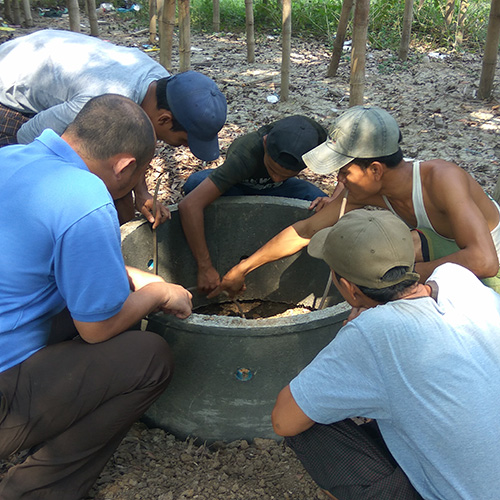Stories of Change

Participants work on constructing a sample latrine.
Masonry training so communities can build sanitary latrines in Myanmar
Our team in Myanmar has been partnering with villages in Maubin township in southwest Myanmar for years. Many communities here are flood-prone and face deep poverty, so our team has helped them prepare for and mitigate flooding, improve child nutrition and improve sanitation in schools and at home.
To further this work, we once again turned to our partner, the Centre for Affordable Water and Sanitation Technology to further strengthen sanitation here. In mid-May a visiting CAWST Global WASH Advisor, Parviz Pulotov, co-led a basic masonry workshop with CWS Engineer, Ko Soe. Thirteen men from five villages joined the session, which focused on building two types of pit latrines. The men gained new knowledge and had a chance to practice new skills so they can help their families and neighbors expand affordable and acceptable latrine availability and use.
Coming together with little knowledge and no masonry skills, the men started by learning about the key points of latrine construction: basic latrine parts, site selection, hole digging, lining components and superstructure options as well as different types of pits, which range in complexity – and cost. All sessions were presented in English and translated as needed with illustrated materials to support Q&A, small group learning and after-class study.
After two days of theory, the group moved to practice by building two latrines of different designs for flood-prone and high-water table areas: one used only concrete rings to line the pit and the other used concrete and bamboo. Eager to learn new techniques as well as basic skills, the trainees strictly followed Parvis and Ko Soe’s instruction, step by step, and they were rewarded for their efforts with two successfully completed sanitary pits.
At the end of four intense days of learning, asking questions, practicing and testing, trainees said they were happy to have learned how to build latrines by doing the work, asking questions and solving problems together with guidance and coaching from CAWST and CWS staff. Most importantly, an experienced local mason joined the workshop and can be an information source and coach, along with Ko Soe, in the future.
At the workshop’s end, after receiving his certificate, one trainee said, “I know now how to build a pit latrine from start to finish, and I really like the [active and interactive] teaching methods used by the trainers; they were different from my past experience. Thanks to the trainers and CWS [for organizing it]”. And another trainee added, “I thought the training would be easy. In reality, while there were things we already knew, [there were other] things we have never come across or known about; so, we learned a lot.”
